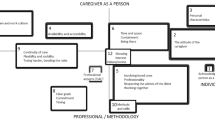Abstract
Past research has found that a positive working alliance between clients and their case managers is modestly correlated with client outcomes. The current study tried to identify the predictors of the working alliance in a sample of 115 clients who were receiving services from Assertive Community Treatment (ACT) teams. All of the clients suffered from severe mental illness, had a substance use disorder and were homeless at baseline. Both the client’s rating and the case manager’s rating of the working alliance were assessed at 3 months and 15 months post baseline. Client characteristics, particularly motivation to change, explained more of the variance of the client’s rating of the alliance than treatment variables or client change on the outcome variables. On the other hand, treatment variables (e.g., the amount of transportation services provided) and client change on the outcome variables explained more of the variance of the case manager’s rating of the alliance.
Similar content being viewed by others
References
Belding M. A., Iguchi M. Y., Morral A. R., McLellan A. T. (1997). Assessing the helping alliance and its impact in the treatment of opiate dependence. Drug and Alcohol Dependence 48: 51–59
Blume A. W., Schmaling K. B. (1997). Specific classes of symptoms predict readiness to change scores among dually diagnosed patients. Addictive Behaviors 22(5): 625–630
Calsyn R. J., Morse G. A., Allen G. (1999). Predicting the helping alliance with people with a psychiatric disability. Psychiatric Rehabilitation Journal 22(3): 283–287
Calsyn, R. J., Morse, G. A., Klinkenberg, W. D., & Lemming, M. R. (2005). Client outcomes and the working alliance in assertive treatment programs. Journal of Case Management, 5, 199–202
Carey K. B., Cocco K. M., Simons J. S. (1996). Concurrent validity of clinicians’ ratings of substance abuse among psychiatric outpatients. Psychiatric Services 47(8): 842–847
Draine J., Solomon P. (1996). Case manager alliance with clients in an older cohort. Community Mental Health Journal 32: 125–134
First M. B., Gibbon M., Spitzer R. L., Williams J. (1996). User’s guide for the structured clinical interview for DSM IV axis I disorders (SCID). Biometrics Research Department, New York State Psychiatric Institute, NY, NY
Horvath A. O., Bedi R. P. (2002). The alliance. In: Norcross J. C. (eds), Psychotherapy relationships that work: therapist contributions and responsiveness to patients. University Press, Oxford
Klinkenberg W. D., Calsyn R. J., Morse G. A. (2002). The case manager’s view of the helping alliance. Care Management Journals 3: 120–126
Klinkenberg W. D., Calsyn R. J., Morse G. A. (1998). The helping alliance in case management for homeless persons with severe mental illness. Community Mental Health Journal 34(6): 569–578
Lukoff O., Neuchterlein K., Ventura J. (1986). Manual for the expanded Brief Psychiatric Rating Scale. Schizophrenia Bulletin 13: 261–276
Martin D. J., Garske J. P, Davis M. K. (2000). Relation of the therapeutic alliance with outcome and other variables: A meta-analytic review. Journal of Consulting and Clinical Psychology 68(3): 438–450
Morse, G. A., Calsyn, R. J., Klinkenberg, W. D., Halminiak, T. W., Wolff, N., Drake, R. E., Yonker, R. D., Lama, G., Lemming, M. R., & McCudden, S. (in press). Treating homeless clients with severe mental illness and substance use disorders: costs and outcomes, Community Mental Health Journal
Neale M. S., Rosenheck R. A. (1995). Therapeutic alliance and outcome in a VA intensive case management program. Psychiatric Services 46(7): 719–721
Priebe S., Gruyters T. (1993). The role of the helping alliance in psychiatric community care: A prospective study. The Journal of Nervous and Mental Disease 181: 552–557
Rollnick S., Heather N., Gold R., Hall W. (1992). Development of a short ‘readiness to change’ questionnaire for use in brief opportunistic interventions among excessive drinkers. British Journal of Addiction, 87: 743–754
Solomon P., Draine J., Delaney M. A. (1995). The working alliance and consumer case management. Journal of Mental Health Administration 22(2): 126–134
Teague G. B., Bond G. R., Drake R. E., (1998). Program fidelity in assertive community treatment: Development and use of a measure. American Journal of Orthopsychiatry 68: 216–232
Tracey T. J., Kokotovic A. M. (1989). Factor structure of the Working Alliance Inventory. Psychological Assessment: A journal of consulting and clinical psychology 1: 207–210
Acknowledgments
The authors thank the study participants for their cooperation in this study; we hope that their lives have improved as a result of their participation. We also appreciate the cooperation of the many agencies that provided treatment to the study participants, particularly Community Alternatives, Places for People, and Peter and Paul Community Services. The following individuals were critical to the execution of the project: Ruth Smith, Mary Maguire, Bill Tourville, Joris Miller, Gretchen Gerteis, Gail Saulnier, Kecia Smith, Dorothy Gano, Melinda Bowen and Jean Mayo. Financial support was provided by the National Institute of Mental Health and the University of Missouri-St. Louis. However, the views expressed in this paper are the sole responsibility of the authors.
Author information
Authors and Affiliations
Additional information
Dr. Robert J. Calsyn and Mr. Lemming are affiliated with the University of Missouri-St. Louis. Dr. Gary A. Morse is affiliated with the Community Alternatives. Dr. W.D. Klinkenberg is affiliated with the Missouri Institute of Mental health.
Rights and permissions
About this article
Cite this article
Calsyn, R.J., Klinkenberg, W.D., Morse, G.A. et al. Predictors of the Working Alliance in Assertive Community Treatment. Community Ment Health J 42, 161–175 (2006). https://doi.org/10.1007/s10597-005-9022-7
Published:
Issue Date:
DOI: https://doi.org/10.1007/s10597-005-9022-7




